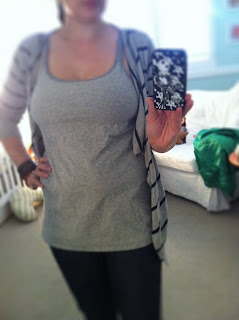I received an email from Babycenter this morning directing me to
this shameless bit of propaganda for the formula industry: a list of seventeen foods to avoid while breastfeeding, sponsored (surprise!) by a formula manufacturer and featuring not one but TWO formula ads per page.
Seventeen! My, that's a long list. I'll bet you never knew breastfeeding was so restrictive for mothers.
That's because it isn't.
And it makes me REALLY angry to see formula companies peddling bad information in an effort to convince mothers that breastfeeding is hard, or restrictive, or inconvenient.
Let's break the list down, shall we?
Coffee: I know of only
one study that has reviewed the relationship between mom's caffeine intake and baby's behavior. That study suggests that mom limit her caffeine intake to 500mg per day. That translates to 5 cups of regular coffee, 2 cups of Starbucks coffee, 5 bottles of Starbucks Frappuccino, 7 Starbucks lattes or 11 cans of Diet Coke. In other words, lactating mothers shouldn't ingest more caffeine than any other sane person might.
Chocolate: There are about 30mg of caffeine in a chocolate bar. So you can have 16 1/2 before you've got to worry about your caffeine limits. Good luck getting through that many without barfing.
Citrus: The vast majority of moms find that they can drink orange juice to their heart's content without causing any tummy distress for their babies. This one falls into the category of "if it seems to affect your own personal baby, avoid it". There is, however, no scientific evidence that citrus fruits are problematic for breastfeeding babies.
Broccoli: Milk is synthesized from blood. Something must be embodied in your blood in order to express itself in your milk. The extra fiber in broccoli is what causes gas. Fiber that exists in your digestive tract, not in your blood. It is simply impossible that broccoli would be to blame for a gassy baby.
Alcohol: Big fat "duh": You shouldn't binge drink while breastfeeding. It is generally agreed, however, that one drink here or there, especially when timed to be consumed 2-3 hours before baby's next feeding, is of little consequence.
Spicy Foods: As with citrus fruits, "If spicy food bugs your own personal baby, don't eat it". There is, however, no medical reason your baby wouldn't be able to drink your milk after you've eaten spicy foods.
Garlic: This one brought on the LOLZ! The one study I know of regarding garlic and breastfeeding indicated that infants sucked longer and took more milk after mom had eaten garlic. Nice try, Similac.
Peanuts, Wheat, Corn, Shellfish, Eggs: All foods that are worth avoiding if you (duh) or your baby's father have a history of allergies to them. Otherwise? Eat up!
Dairy and Soy: If your baby is excessively gassy and seems to be experiencing tummy pain, and IF you think that gassiness is linked to your diet (rather than to the myriad of other reasons a baby might be gassy), then it is likely the culprit in your diet is either dairy or soy, and it is worth a try to eliminate those two things and see if baby doesn't improve. I find it hilarious that Similac mentioned this without bothering to mention that their (indeed, all) formulas are all either dairy or soy based, both of which are far harder on baby's tummy than breastmilk in the best of times, let alone in instances of diary or soy intolerance. If baby has a dairy or soy allergy, it is ESPECIALLY important that baby be breastfed!
Fish: While it would be prudent for nursing mothers to avoid certain types of fish which are high in mercury (a good list is
here), it is important to note that in the studies that have been done, breastfed infants, even those whose mothers consumed significant quantities of mercury, scored better on developmental tests than formula fed babies. Is mercury a good thing in breastmilk? No. But is mercury tainted breastmilk still better for infants than formula? Yep.
Peppermint and Parsley: These are herbs known to reduce milk supply in therapeutic doses. It is unlikely that consuming the amounts typically used in cooking would cause a decrease in milk supply. However, if a mother was trying to maximize her supply, she might want to avoid these as well as a few others, listed
here. Avoiding peppermint and parsley certainly isn't mandatory, though.
Breastfeeding isn't rocket science. Moms should use common sense with regards to alcohol, caffeine and environmental contaminants. In the event baby seems fussy after mom eats a certain food, by all means she can try avoiding that food (which may or may not help!). To imply, however, that there is a set in stone list of things (SEVENTEEN THINGS!!!) that nursing mothers mustn't eat is just complete fallacy. For shame, Similac.








